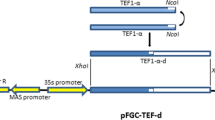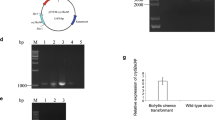Abstract
Weeds are a significant part of the pests limiting crop production. Currently, chemical herbicides are widely used for weed control. Environment pollution and the rise of resistant strains highlight the need for new herbicides. Nep1 is a natural bio-herbicide protein which is an effective necrosis stimulant in dicotyledonous weeds. In this study, the cDNA encoding nep1 was isolated form Fusarium oxysporum, cloned and overexpressed in Escherichia coli. The Nep1 inclusion body was purified and refolded. For biological assay, the recombinant Nep1 was applied on Sinapis arvensis, as a chemical herbicide-resistant weed, and on Nicotiana tabacum, as a model plant. Our results show a significant necrosis on the leaves of S. arvensis and N. tabacum after spraying 50 μg/ml of the recombinant protein.




Similar content being viewed by others
References
Amsellem Z, Cohen BA, Gressel J (2002) Engineering hypervirulence in a mycoherbicidal fungus for efficient weed control. Nat Biotechnol 20:1035–1039
Bae H, Kim SH, Kim MS, Sicher RC, Lary D, Strem MD, Natarajan S, Bailey BA (2008) The drought response of Theobroma cacao (cacao) and the regulation of genes involved in polyamine biosynthesisby drought and other stresses. Plant Physiol Biochem 46:174–188
Bailey BA (1995) Purification of a protein from culture filtrates of Fusarium oxysporum that induces ethylene and necrosis in leaves of Erythroxylum coca. Phytopathology 85:1250–1255
Bailey BA, Collins R, Anderson JD (2000a) Factors influencing the herbicidal activity of Nep1, a fungal protein that induces the hypersensitive response in Centaurea maculosa. Weed Sci 48:776–785
Bailey BA, Apel-Birkhold PC, Akingbe OO, Ryan JL, O’Neill NR, Anderson JD (2000b) Nep1 proteinfrom Fusarium oxysporum enhances biological control of opium poppy by Pleospora papaveracea. Phytopathology 90:812–818
Blackshaw RE, Harker KN (2002) Selective weed control with glyphosate in glyphosate-resistant spring wheat (Triticum aestivum) 1. Weed Technol 16:885–892
Boghigian BA, Pfeifer BA (2008) Current status, strategies, and potential for the metabolic engineering of heterologous polyketides in Escherichia coli. Biotechnol Lett 30:1323–1330
Chutia M, Mahanta J, Bhattacharyya N, Bhuyan M, Boruah P, Sarma T (2007) Microbial herbicides for weed management: prospects, progress and constraints. Plant Pathol J 6:210–218
Dallal Bashi Z, Hegedus DD, Buchwaldt L, Rimmer SR, Borhan MH (2010) Expression and regulation of Sclerotinia sclerotiorum necrosis and ethylene-inducing peptides (NEPs). Mol Plant Pathol 11:43–53
Demain AL, Vaishnav P (2009) Production of recombinant proteins by microbes and higher organisms. Biotechnol Adv 27:297–306
Frisen GH, Wall DA (1991) Control of Sinapis arvensis in safflower with postemergence. Crop Prot 10:74–77
Gijzen M, Nürnberger T (2006) Nep1-like proteins from plant pathogens: recruitment and diver sification of the NPP1 domain across taxa. Phytochemistry 67:1800–1807
Hoagland RE, Boyette CD, Weaver MA, Abbas HK (2007) Bioherbicides: research and risks. Toxin Rev 26:313–342
Keates SE, Kostman TA, Anderson JA, Bailey BA (2003) Altered gene expression in three plant species in response to treatment with Nep1, a fungal protein that causes necrosis. Plant Physiol 132:1610–1622
Li Y, Sun Z, Zhuang X, Xu L, Chen S, Li M (2003) Research progress on microbial herbicides. Crop Prot 22:247–252
Lutman P (2002) Estimation of seed production by Stellaria media, Sinapis arvensis and Tripleurospermum inodorum in arable crops. Weed Res 42:359–369
Martin SG, Van Acker RC, Friesen LF (2001) Critical period of weed control in spring canola. Weed Sci 49:326–333
Motteram J, Küfner I, Deller S, Brunner F, Hammond-Kosack KE, Nürnberger T, Rudd JJ (2009) Molecular characterization and functional analysis of MgNLP, the sole NPP1 domain-containing protein, from the fungal wheat leaf pathogen Mycosphaerella graminicola. Mol Plant Microbe Interact 22:790–799
Ottmann C, Luberacki B, Küfner I, Koch W, Brunner F, Weyand M, Mattinen L, Pirhonen M, Anderluh G, Seitz HU (2009) A common toxin fold mediates microbial attack and plant defense. Proc Natl Acad Sci USA 106:10359–10364
Saxena S, Pandey AK (2001) Microbial metabolites as eco-friendly agrochemicals for the next millennium. Appl Microbiol Biotechnol 55:395–403
Schouten A, Baarlen PV, van Kan JAL (2008) Phytotoxic Nep1-like proteins from the necrotrophic fungus Botrytis cinerea associate with membranes and the nucleus of plant cells. New Phytol 177:493–505
Singh SM, Panda AK (2005) Solubilization and refolding of bacterial inclusion body proteins. J Biosci Bioeng 99:303–310
Acknowledgments
The authors would like to thank Dr. Ali Mohammad Latifi for his valuable support.
Author information
Authors and Affiliations
Corresponding author
Rights and permissions
About this article
Cite this article
Moghimi, H., Hamedi, J., Sepehrizadeh, Z. et al. Overexpression of recombinant Nep1 in Escherichia coli and its use as a biological agent for control of Sinapis arvensis . Ann Microbiol 63, 669–675 (2013). https://doi.org/10.1007/s13213-012-0517-5
Received:
Accepted:
Published:
Issue Date:
DOI: https://doi.org/10.1007/s13213-012-0517-5




